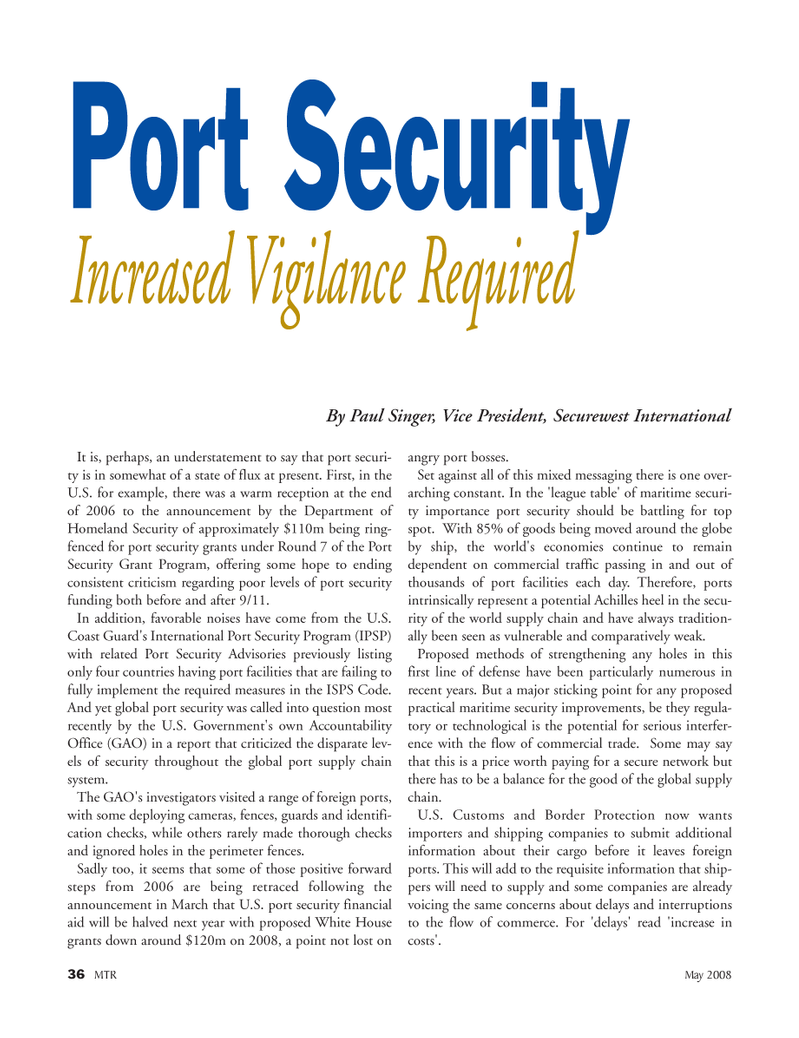
Page 36: of Marine Technology Magazine (May 2008)
Undersea Defense Edition
Read this page in Pdf, Flash or Html5 edition of May 2008 Marine Technology Magazine
36 MTR May 2008
It is, perhaps, an understatement to say that port securi- ty is in somewhat of a state of flux at present. First, in the
U.S. for example, there was a warm reception at the end of 2006 to the announcement by the Department of
Homeland Security of approximately $110m being ring- fenced for port security grants under Round 7 of the Port
Security Grant Program, offering some hope to ending consistent criticism regarding poor levels of port security funding both before and after 9/11.
In addition, favorable noises have come from the U.S.
Coast Guard's International Port Security Program (IPSP) with related Port Security Advisories previously listing only four countries having port facilities that are failing to fully implement the required measures in the ISPS Code.
And yet global port security was called into question most recently by the U.S. Government's own Accountability
Office (GAO) in a report that criticized the disparate lev- els of security throughout the global port supply chain system.
The GAO's investigators visited a range of foreign ports, with some deploying cameras, fences, guards and identifi- cation checks, while others rarely made thorough checks and ignored holes in the perimeter fences.
Sadly too, it seems that some of those positive forward steps from 2006 are being retraced following the announcement in March that U.S. port security financial aid will be halved next year with proposed White House grants down around $120m on 2008, a point not lost on angry port bosses.
Set against all of this mixed messaging there is one over- arching constant. In the 'league table' of maritime securi- ty importance port security should be battling for top spot. With 85% of goods being moved around the globe by ship, the world's economies continue to remain dependent on commercial traffic passing in and out of thousands of port facilities each day. Therefore, ports intrinsically represent a potential Achilles heel in the secu- rity of the world supply chain and have always tradition- ally been seen as vulnerable and comparatively weak.
Proposed methods of strengthening any holes in this first line of defense have been particularly numerous in recent years. But a major sticking point for any proposed practical maritime security improvements, be they regula- tory or technological is the potential for serious interfer- ence with the flow of commercial trade. Some may say that this is a price worth paying for a secure network but there has to be a balance for the good of the global supply chain.
U.S. Customs and Border Protection now wants importers and shipping companies to submit additional information about their cargo before it leaves foreign ports. This will add to the requisite information that ship- pers will need to supply and some companies are already voicing the same concerns about delays and interruptions to the flow of commerce. For 'delays' read 'increase in costs'.
Port Security
Increased Vigilance Required
By Paul Singer, Vice President, Securewest International
MTR#4 (33-48).qxd 5/13/2008 10:23 AM Page 36

 35
35

 37
37
